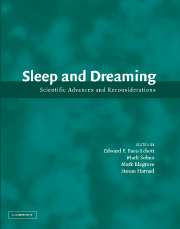Book contents
- Frontmatter
- Contents
- Preface
- Introduction
- 1 Dreaming and the brain: Toward a cognitive neuroscience of conscious states
- 2 Dreaming and REM sleep are controlled by different brain mechanisms
- 3 A review of mentation in REM and NREM sleep: “Covert” REM sleep as a possible reconciliation of two opposing models
- 4 The case against memory consolidation in REM sleep
- 5 The reinterpretation of dreams: An evolutionary hypothesis of the function of dreaming
- Open Peer Commentary and Authors' Responses
- References
- Postscript: Recent findings on the neurobiology of sleep and dreaming
- Index
3 - A review of mentation in REM and NREM sleep: “Covert” REM sleep as a possible reconciliation of two opposing models
Published online by Cambridge University Press: 11 January 2010
- Frontmatter
- Contents
- Preface
- Introduction
- 1 Dreaming and the brain: Toward a cognitive neuroscience of conscious states
- 2 Dreaming and REM sleep are controlled by different brain mechanisms
- 3 A review of mentation in REM and NREM sleep: “Covert” REM sleep as a possible reconciliation of two opposing models
- 4 The case against memory consolidation in REM sleep
- 5 The reinterpretation of dreams: An evolutionary hypothesis of the function of dreaming
- Open Peer Commentary and Authors' Responses
- References
- Postscript: Recent findings on the neurobiology of sleep and dreaming
- Index
Summary
Abstract: Numerous studies have replicated the finding of mentation in both rapid eye movement (REM) and nonrapid eye movement (NREM) sleep. However, two different theoretical models have been proposed to account for this finding: (1) a one-generator model, in which mentation is generated by a single set of processes regardless of physiological differences between REM and NREM sleep; and (2) a two-generator model, in which qualitatively different generators produce cognitive activity in the two states. First, research is reviewed demonstrating conclusively that mentation can occur in NREM sleep; global estimates show an average mentation recall rate of about 50% from NREM sleep – a value that has increased substantially over the years. Second, nine different types of research on REM and NREM cognitive activity are examined for evidence supporting or refuting the two models. The evidence largely, but not completely, favors the two-generator model. Finally, in a preliminary attempt to reconcile the two models, an alternative model is proposed that assumes the existence of covert REM sleep processes during NREM sleep. Such covert activity may be responsible for much of the dreamlike cognitive activity occurring in NREM sleep.
Keywords: cognition in sleep; dreaming; NREM sleep; REM sleep; sleep mentation
Introduction
The discovery of REM and NREM mentation
Initial reports of an association between REM sleep and vivid dreaming (Aserinsky & Kleitman 1953; Dement 1955; Dement & Kleitman 1957a; 1957b) inspired studies designed to clarify relationships between sleep physiology and dream imagery. A perspective emerged – referred to by many as the “REM sleep = dreaming” perspective (see Berger 1994; Foulkes 1993b; Lavie 1994; Nielsen & Montplaisir 1994; Rechtschaffen 1994 for overview) – from …
- Type
- Chapter
- Information
- Sleep and DreamingScientific Advances and Reconsiderations, pp. 59 - 74Publisher: Cambridge University PressPrint publication year: 2003
- 12
- Cited by



